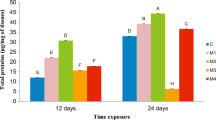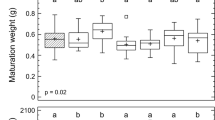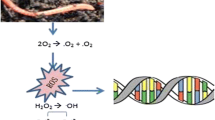Abstract
Nanomaterials have increasingly gained a great amount of interest due to their widespread applications, while their potential impacts on invertebrates in soil lack thorough investigation. This study is mainly aimed at determining the acute and subacute toxicity to the earthworm Eisenia fetida, induced by different levels of nanoscale zerovalent iron (nZVI) (100, 500, 1000 mg kg−1) in natural soils. The results showed that compared to the controls, exposure to 500 and 1000 mg kg−1 of nZVI significantly (P < 0.05) inhibited growth and respiration and increased avoidance response in earthworms. The perturbations of antioxidant enzyme activities (superoxide dismutase—SOD and catalase—CAT), malondialdehyde (MDA) content, and reactive oxygen species (ROS) clearly revealed that oxidative stress was induced in E. fetida exposed to nZVI. Good correlations were observed in current results among the growth, respiration, MDA, and ROS (R > 0.8; P < 0.05), and that ROS was the most sensitive parameter in response to the stress caused by nZVI. Additionally, the histopathological examination of transverse sections of the exposed earthworms passing through the body wall illustrated that there was a serious injury in epidermal tissue after an exposure of 28 days. These findings will provide a comprehensive understanding of toxicological effects of nZVI in a soil-earthworm system.








Similar content being viewed by others
References
Adeleye AS, Stevenson LM, Su Y, Nisbet RM, Zhang Y, Keller AA (2016) Influence of phytoplankton on fate and effects of modified zerovalent iron nanoparticles. Environ Sci Technol 50:5597–5605
Amorim MJB, Scott-Fordsmand JJ (2012) Toxicity of copper nanoparticles and CuCl2 salt to Enchytraeus albidus worms: survival, reproduction and avoidance responses. Environ Pollut 164:164–168
Chen PJ, Su CH, Tseng CY, Tan SW, Cheng CH (2011) Toxicity assessments of nanoscale zerovalent iron and its oxidation products in medaka (Oryzias latipes) fish. Mar Pollut Bull 63:339–346
Chen PJ, Tan SW, Wu WL (2012) Stabilization or oxidation of nanoscale zerovalent iron at environmentally relevant exposure changes bioavailability and toxicity in medaka fish. Environ Sci Technol 46:8431–8439
Chowdhury AI, Krol MM, Kocur CM, Boparai HK, Weber KP, Sleep BE, O’Carroll DM (2015) nZVI injection into variably saturated soils: field and modeling study. J Contam Hydrol 183:16–28
Clark CJ II, Rao PSC, Annable MD (2003) Degradation of perchloroethylene in cosolvent solutions by zerovalent iron. J Hazard Mater 96:65–78
Dotan Y, Lichtenberg D, Pinchuk I (2004) Lipid peroxidation cannot be used as a universal criterion of oxidative stress. Prog Lipid Res 43:200–227
El-Temsah YS, Joner EJ (2012) Ecotoxicological effects on earthworms of fresh and aged nano-sized zerovalent iron (nZVI) in soil. Chemosphere 89:76–82
Foyer CH, Shigeoka S (2011) Understanding oxidative stress and antioxidant functions to enhance photosynthesis. Plant Physiol 155:93–100
Hao LH, Wang ZY, Xing BS (2009) Effect of sub-acute exposure to TiO2 nanoparticles on oxidative stress and histopathological changes in juvenile carp (Cyprinus carpio). J Environ Sci 21:1459–1466
Hu C, Zhang L, Wang W, Cui Y, Li M (2014) Evaluation of the combined toxicity of multi-walled carbon nanotubes and sodium pentachlorophenate on the earthworm Eisenia fetida using avoidance bioassay and comet assay. Soil Biol Biochem 70:123–130
Hu S, Zhang W, Li J, Lin K, Ji R (2016) Antioxidant and gene expression responses of Eisenia fetida following repeated exposure to BDE209 and Pb in a soil-earthworm system. Sci Total Environ 556:163–168
ISO (2007) Soil quality-avoidance test for testing the quality of soils and effects of chemicals—part 1: test with earthworms (Eisenia fetida and Eisenia andrei) ISO Guideline 17512–1, Geneve, Switzerland
Khalil AM (2015) Neurotoxicity and biochemical responses in the earthworm Pheretima hawayana exposed to TiO2 NPs. Ecotoxicol Environ Saf 122:455–461
Kwak JI, An YJ (2015) Ecotoxicological effects of nanomaterials on earthworms: a review. Human and Ecological Risk Assessment: An International Journal 21:1566–1575
Lankadurai BP, Nagato EG, Simpson AJ, Simpson MJ (2015) Analysis of Eisenia fetida earthworm responses to sub-lethal C60 nanoparticle exposure using 1H-NMR based metabolomics. Ecotoxicol Environ Saf 120:48–58
Lee C, Kim JY, Lee WI, Nelson KL, Yoon J, Sedlak DL (2008) Bactericidal effect of zerovalent iron nanoparticles on Escherichia coli. Environ Sci Technol 42:4927–4933
Li Y, Hu Y, Ai X, Qiu J, Wang X (2015) Acute and sub-acute effects of enrofloxacin on the earthworm species Eisenia fetida in an artificial soil substrate. Eur J Soil Biol 66:19–23
Li Y, Tang H, Hu Y, Wang X, Ai X, Tang L, Matthew C, Cavanagh J, Qiu J (2016) Enrofloxacin at environmentally relevant concentrations enhances uptake and toxicity of cadmium in the earthworm Eisenia fetida in farm soils. J Hazard Mater 308:312–320
Liu J, Xiong K, Ye X, Zhang J, Yang Y, Ji L (2015) Toxicity and bioaccumulation of bromadiolone to earthworm Eisenia fetida. Chemosphere 135:250–256
Ma X, Gurung A, Deng Y (2013) Phytotoxicity and uptake of nanoscale zerovalent iron (nZVI) by two plant species. Sci Total Environ 443:844–849
Marsalek B, Jancula D, Marsalkova E, Mashlan M, Safarova K, Tucek J, Zboril R (2012) Multimodal action and selective toxicity of zerovalent iron nanoparticles against cyanobacteria. Environ Sci Technol 46:2316–2323
Matheson LJ, Tratnyek PG (1994) Reductive dehalogenation of chlorinated methanes by iron metal. Environ Sci Technol 28:2045–2053
Nelson DW, Sommers LE (1982) Carbon, organic carbon and organic matter. In: Page AL (ed) Methods of soil analysis, part 2: chemical and microbiological properties. Am Soc Agron, Madison, pp 539–580
Nowack B, Bucheli TD (2007) Occurrence, behavior and effects of nanoparticles in the environment. Environ Pollut 150:5–22
OECD (1984) OECD guideline for testing of chemicals. Earthworm acute toxicity. OECD, Paris. No. 207
Phenrat T, Long TC, Lowry GV, Veronesi B (2008) Partial oxidation (“aging”) and surface modification decrease the toxicity of nanosized zerovalent iron. Environ Sci Technol 43:195–200
Park K, Tuttle G, Sinche F, Harper SL (2013) Stability of citrate-capped silver nanoparticles in exposure media and their effects on the development of embryonic zebrafish (Danio rerio). Arch Pharm Res 36:125–133
Ribeiro S, Sousa J, Nogueira A, Soares A (2001) Effect of endosulfan and parathion on energy reserves and physiological parameters of the terrestrial isopod Porcellio dilatatus. Ecotoxicol Environ Saf 49:131–138
Saccà ML, Fajardo C, Costa G, Lobo C, Nande M, Martin M (2014) Integrating classical and molecular approaches to evaluate the impact of nanosized zerovalent iron (nZVI) on soil organisms. Chemosphere 104:184–189
Tang H, Yan Q, Wang X, Ai X, Robin P, Matthew C, Qiu J, Li X, Li Y (2016) Earthworm (Eisenia fetida) behavioral and respiration responses to sublethal mercury concentrations in an artificial soil substrate. Appl Soil Ecol 104:48–53
Tosco T, Papini MP, Viggi CC, Sethi R (2014) Nanoscale zerovalent iron particles for groundwater remediation: a review. J Clean Prod 77:10–21
Wang Z, Cui Z, Liu L, Ma Q, Xu X (2016) Toxicological and biochemical responses of the earthworm Eisenia fetida exposed to contaminated soil: effects of arsenic species. Chemosphere 154:161–170
Zhang WX (2003) Nanoscale iron particles for environmental remediation: an overview. J Nanopart Res 5:323–332
Zhang W, Liu K, Li J, Chen L, Lin K (2015b) Uptake and depuration kinetics of lead (Pb) and biomarker responses in the earthworm Eisenia fetida after simultaneous exposure to decabromodiphenyl ether (BDE209). Ecotoxicol Environ Saf 113:45–51
Zhang W, Liu K, Li J, Liang J, Lin K (2015a) Impacts of BDE209 addition on Pb uptake, subcellular partitioning and gene toxicity in earthworm (Eisenia fetida). J Hazard Mater 300:737–744
Zhao X, Liu W, Cai Z, Han B, Qian T, Zhao D (2016) An overview of preparation and applications of stabilized zerovalent iron nanoparticles for soil and groundwater remediation. Water Res 100:245–266
Zhao X, Wang S, Wu Y, You H, Lv L (2013) Acute ZnO nanoparticles exposure induces developmental toxicity, oxidative stress and DNA damage in embryo-larval zebrafish. Aquat Toxicol 136:49–59
Acknowledgments
This research was supported by projects of the National Natural Science Foundation of China (41371467), the Shanghai Pujiang Program (15PJD013), and the National Key Research and Development Program (2016YFD0800405).
Author information
Authors and Affiliations
Corresponding authors
Additional information
Responsible Editor: Thomas D. Bucheli
Rights and permissions
About this article
Cite this article
Liang, J., Xia, X., Zhang, W. et al. The biochemical and toxicological responses of earthworm (Eisenia fetida) following exposure to nanoscale zerovalent iron in a soil system. Environ Sci Pollut Res 24, 2507–2514 (2017). https://doi.org/10.1007/s11356-016-8001-6
Received:
Accepted:
Published:
Issue Date:
DOI: https://doi.org/10.1007/s11356-016-8001-6




